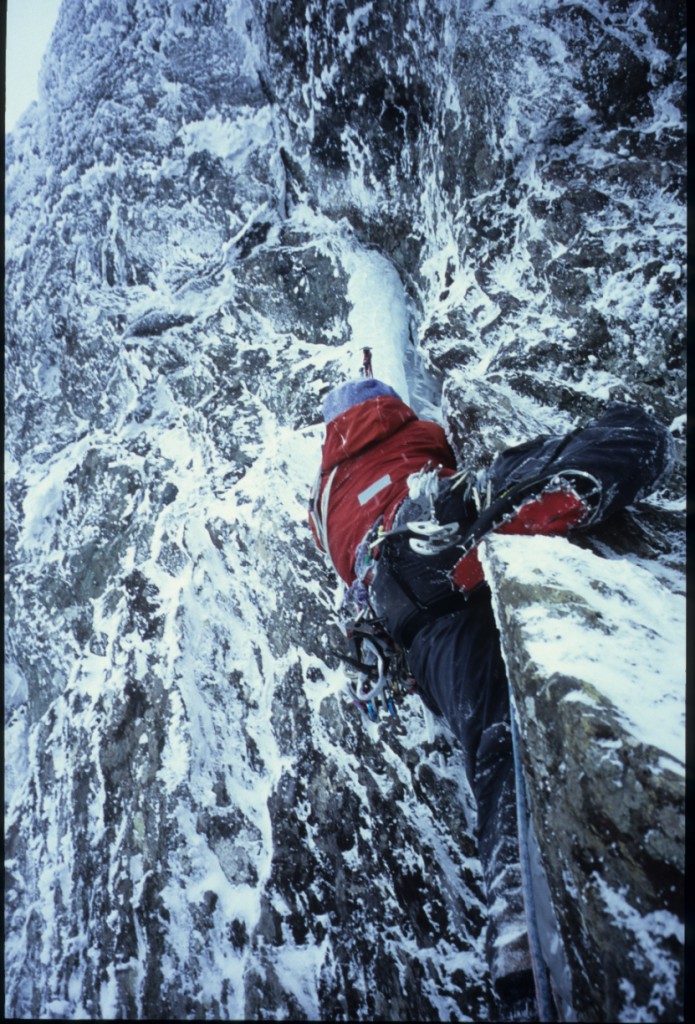Winter is becoming like Christmas advertising, it appears to start earlier each year. Or does it? Does winter actually have to start nowadays before we all rush to the hills? Winter climbing in Britain has become very popular, especially with the rise in technology and the improvement of modern equipment. Everyone appears to be chomping to don bits of metal and scratch around at the first dusting.
As I sit here, tapping-away, the internet is full of North Wales condition reports and routes already in the bag. Personally it just hasn’t felt cold enough and on the QT, several people have told me of marginal, only partly frozen turf conditions. I’m not saying everything that’s been climbed over the last week or so has not been in condition – Clogwyn Du certainly looked in and reports of routes climbed on that brooding cliff have backed this. I’m not finger pointing, but climbers, try to be honest with yourself, was your route really in acceptable winter condition or are you possibly the thin edge that eventually causes winter climbing in Wales to be restricted or even banned?
As I ran up the Llanberis Pass in the pouring rain, the spray from the cars pelted and I watched the cliffs turn a darker shade of dark by the minute. Numb feet splashed through puddles, the wind sliced – I certainly had the moody blues. I knew people were out climbing, I wanted to be out climbing, I wanted that experience, but would the long term consequences of damaging the delicate have massive repercussions for everyone in the future? Feet crunched on shining, slippery slate flakes as I gasped the final rise of the Miners Track before turning around at Llyn Llydaw – I knew I could be patient.
When it comes to keen for winter, being psyched – hanging from handles, teetering on front points and hunting for the unclimbed, hunting for another great memory of a shared experience – I think I rank quite high, but it just didn’t feel like winter, it all felt, well, soggy and marginal and in these conditions even I’m prepared to wait, but on inspection of the internet I could see there had been loads of folk out climbing in Wales and I really don’t believe, given the weather, they were all perfectly frozen.
Later in the evening I visited the Indi climbing wall where I completed an hour of chins and lock-offs, press-ups and knee raises, while hanging from Axes. Physical preparation early in the winter or even in autumn, if you want to push your grade, is, in my mind, vital. Vital not only to get to the top of something that tests, but vital for the rock and the vegetation. In Britain now we have dedicated areas for dry tooling which is a great way to prepare the body and mind and really get yourself fit.
A couple of years ago I climbed El Mancho on Clogwyn Du and I was shocked at how scratched, scarred and furrowed the soft Rhyolite was from where feet had thrashed. With good physical preparation and the ability to lock-off on placements as good as they are on El Mancho – and they are very good – there really is no excuse to be peddling and damaging.
Pushing your personal boundaries is of course what climbing is about, it is for me anyway, but there appears to be a lot of folk nowadays who think they can just jump straight to climbing VI/6 – and of course with the improvements of equipment they probably can – but maybe with a bit more patience and experience and strength they will damage the rock and the turf less and have a more enjoyable time.
I know you could say that anyone pushing their grade is going to struggle and peddle and damage, but if you have physically prepared and you have gradually built up the experience, you will know where to place your front-points and how to move smoothly over steep rock. Understanding that the pick placement is good makes you less nervous, you will be confident – which in turn reduces the doubt and the trashing of a delicate environment.
Also the condition of the metal stuff you use is very important. It is vital to have super sharp pointy bits for mixed climbing, more important in fact than for ice, a thing that appears to surprise some people. Front points and picks need to be razor sharp. Blunt picks don’t bite and blunt front points skate. If in doubt buy new picks and front points – easy for me to say I know being sponsored, but it really does make a massive difference and in the end damages the crags less.
The medium we move across to fulfil our winter climbing ambitions is the most important part of our activity – this medium, the rock and vegetation are delicate and given the ever increasing popularity of winter climbing and the pressure on the crags we need to treat them with respect. None of us are innocent, winter climbing damages no-matter-what and on occasion we find ourselves on a pitch as the temperature increases and the turf becomes soft, but maybe on those marginal days, before you set out, before you get committed, ask yourself the question, is it worth the possible consequences?













Well done Mr Bullock couldnt agree with you more.
Wise words Nick – it’s great to hear such a considered attitude from someone a lot of winter climbers in the UK (including myself) look up to as a role model. Here’s hoping for a fantastic deep winter!
Hi Nick.
I have thought this for a few years now, but unfortunately as a relative winter novice my opinion as much as I like to share it will fall on deaf ears. Hopefully someone like you making a ethical and environmental point will help the situation.
BTW how many one armers do I need to be able to do off axes before I am allowed on a VI,6?
All the best
Mark
This bit:
‘feet crunched on shining, slippery slate flakes as I gasped the final rise of the Miners Track’
Just so! Gorgeous!
!! beware the lurking glimpse-poem!!
feet crunched on
shining slip
-pery flakes as I
gasped the final
rise of the Miner’s Track
or (more conventional, but no less good for that):
feet crunched
on shining
slippery flakes
as I gasped
the final rise
of The Miners’ Track
Ha, knew you would like that bit PP… I enjoyed writing it!